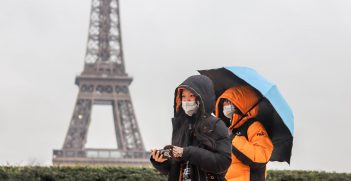Kenya's Population Rise: How COVID-19 Containment Measures Will Affect Kenya's Depressed Economy

As the world grapples with measures to contain the spread of COVID-19 and minimise fatalities, Kenya is on the verge of a new challenge. Due to measures aimed at curbing the spread of the virus, Kenya may face a dramatic increase in population that will have far-reaching and long-term effects.
After its first case of COVID-19 was reported on 12 March 2020, the Kenyan government moved swiftly to implement a raft of containment measures in accordance with World Health Organization protocols. In-person teaching was suspended in all learning and training institutions. Students were asked to return home and wait for further communication. Stricter measures, such as lockdowns in Nairobi and the port city of Mombasa, were introduced, in view of their high population density and prevalence of informal settlements. One social impact of this lockdown is predicted to be an abnormal increase in population.
In Kenya, birth control measures have largely been ignored. According to the United Nations Population Fund (UNFPA), lack of access to safe and effective family planning methods for women are attributed to reasons ranging from a lack of information or services to the lack of support from family or community. Statistics from the last population and census exercise suggest that Kenya’s population currently stands at 50,000,000. Out of this number, youth account for approximately 60 percent.
Recently, media reports citing data from a government-managed health information system revealed that up to 4,000 adolescent girls visited health facilities for antenatal services in just the County of Machakos between March and June 2020. Even though the statistics were quickly dismissed by government authorities, a report published by the African Population and Health Research Centre has raised fears that COVID-19 could worsen the problem of teenage pregnancies in Kenya. The report further says that with the loss of livelihoods, particularly in low-income households, some children may be forced into income-generating activities to support their families’ survival. The document explains that the alarming rate of teenage pregnancies in Kenya, which might be a result of school closure, poverty, and sexual harassment, is projected to rise during the COVID-19 lockdowns.
Given the worrying trend, there are predictions that Kenya might have up to 4,000,000 new babies born between February and June 2021. This would mean a dramatic increase in citizens, by approximately nine percent, within eighteen months of the census conducted in August 2019. With the already soaring cases of youth unemployment, overpopulated public schools, scarce social amenities, and a ravaged economy, the government might not be happy with a a population boom.
The most vulnerable to unplanned pregnancies are teenagers living in informal settlements, including the Kibra, Korogocho, Mathare, and Mukuru slums of Nairobi and other similar settlements in Mombasa, Nakuru, Eldoret, and Kisumu cities. Such settlements are characterised by over-crowding, extreme poverty, and an absence of social amenities. Other media reports identify the coast of Kenya as a potential epicenter for child pregnancies as COVID-19 ravages the region.
For a long time, tourism has been the main livelihood for the local people. However, COVID-19 has dealt the sector a devastating blow. Many jobs have been lost and livelihoods adversely affected. A report compiled by Dorcas Wangira for Citizen Television titled “Teenage Pregnancy Crisis: COVID-19 Worsens teenage pregnancy in Kilifi County” indicates that the pandemic has pushed tourism to an all-time low, and poverty has risen to levels never seen before. Consequently, lost livelihoods and extreme desperation to survive has exacerbated the prevalence of teenage pregnancies.
A video clip produced by K24, a local Television channel, has escalated the fear that sexual acts involving teenagers are on the rise. The video, that has now gone viral, shows school children below eighteen years of age who meet often in Nairobi’s Michuki Park to engage in sexual activities and pose for nude photos, which they later share on Instagram. Police confirmed that indeed this was occurring with school-going teenagers from different parts of Kenya.
In response, the Kenya Union of Post-Primary Teachers (KUPPET) has raised the alarm and called upon government to consider setting up special classrooms for girls with children. On 6 July, 2020, during his ninth address to the nation on the Coronavirus pandemic, the president himself raised concerns about rising cases of teenage pregnancies. He instructed the National Crime Research Centre to investigate the matter with a view to bringing to book people he termed as “violators of the rights of the child,” perhaps in reference to child custodians for failure to offer protection, andas well as adults engaging in sexual acts with children.
Way back in 1994, the Ministry of Education introduced a policy that enabled teenage mothers to continue their schooling after delivery. This policy is backed by the 2010 Constitution of Kenya that gives every individual a right to education, and is supported by the Forum for African Women Educationalists (FAWEK). FAWEK has been on the forefront in advocating for teenagers with children who wish to continue with education to be able to do so in an environment free from stigma and discrimination. Should Kenya now “be blessed” with an additional 3,000,000 babies from teenage mothers, the exchequer would be forced to squeeze water out of a stone to build special learning infrastructure for students with children.
And the problem looks set to continue. While other sectors of the economy are slowly being opened, secondary schools have remained closed. The minster for education, Professor George Magoha, has been quoted in the local media saying challenges associated with implementing social distancing is the main reason for the continued closure of schools. According to the Ministry of Education, classrooms in Kenya hold between 50-65 students instead of the recommended number of 40. Already, officials are scratching their heads and agonising over where to get funds to build additional classrooms, students hostels, and dinning places when schools reopen. It is a mind-boggling dilemma, as each public school needs at least twice the existing facilities.
Sadly, this is not all. According to the UNESCO, the average teacher-pupil ratio for Kenya in the last 5 years has been 56:1, against the recommended 40:1. In view of this, the Kenya National Union of Teachers, as well as education experts, have piled pressure on the government to recruit more teachers in order to help the situation. With a possible increase in the number of learners with babies, the government might have to dig deep into an already dilapidated pocket to not only train new staff, but also hire special teachers to assuage the needs of leaners with children.
Already, the government is operating on a shoestring budget. Kenya’s GDP in 2019 was $99.246 billion. The Cabinet secretary for finance read a budget for the 2020/2021 financial year of 1.89 trillion Kenyan shillings, which is equivalent to 16 percent of the GDP. While the budget looks admirable and highly ambitious by Sub-Saharan standards, the underlying problems within it are numerous. For example, more than half the estimated expenditure will come from foreign and local borrowing. Unfortunately any more borrowing is like rubbing salt on a festering wound, as the government is already choking with a debt of KES 6.5 trillion.
With all these challenges, it remains to be seen whether treasury technocrats will view the baby boom as a loss or gain. Whether Kenyans will celebrate or curse the arrival of the newborns, and how the government will re-engineer existing development plans to respond to the challenge posed by a population surge, is still to be discovered.
Enock Mac’Ouma is a member of a Working Group established by the African Union Scientific Technical and Research Commission. The research group has a mandate to explore Africa’s indigenous knowledge to preventing and controlling emerging and infectious diseases on the continent like COVID-19. He is also a Tutorial/Research Fellow in the School of Information, Communication and Media Studies at Rongo University in Kenya.
This article is published under a Creative Commons License and may be republished with attribution.





